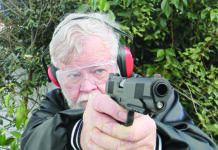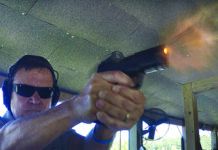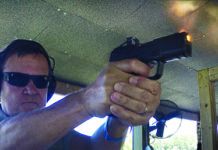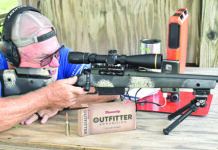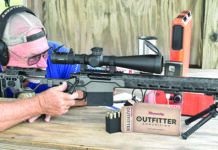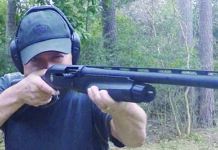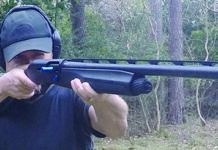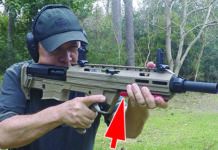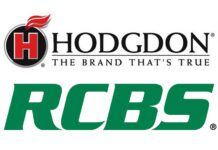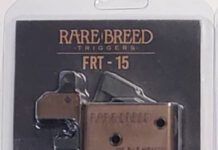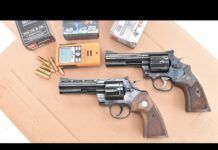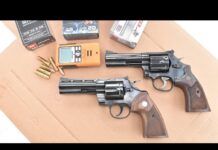At Gun Tests we constantly seek ways to follow up on the service life of the guns we test. When possible, we track the very pistols and long guns that appear on these pages by keeping in touch with their owners, which in some cases are our testers but more often are readers who have bought actual test guns. Another way of tracking the reliability and satisfaction that a firearm can bring is to contact gunsmiths, retail outlets or the operators of public shooting ranges who add them to range rental-gun fleets.
We recently had occasion to test several revolvers previously reviewed and recommended in these pages with an eye toward gathering data about their longevity, a topic GT readers often quiz us about, but which we don’t include in our head-to-head tests because of time constraints. We found products that had gotten Buy recommendations in the past (we didn’t see the point of evaluating the durability of products we didn’t like) and put them through their paces again to see if we could find breakdowns in their performance. At a public range that offers gun rentals, we found a five-shot .357 magnum Ruger SP101, Ruger’s .44 Magnum Redhawk, and a 4-inch Smith & Wesson Model 19 (.357 magnum). We also reviewed one non-rental product, a S&W 686+, that we knew to have a high round count for its young age.
The Smith & Wesson 686+, a staffer’s carry revolver made and shipped in early 1999, was by far the youngest gun in the test, having 3,000 rounds fired in it. Still, that’s a lifetime of use for some shooters. Our intention is to periodically revisit how the gun is doing as it ages and update you on any problems we find. Ruger’s records department said the SP101 KSP321X was shipped in August 1998. Range records indicate it digested between 10,000 and 12,000 rounds. The .44 Magnum Redhawk RH44, shipped in May 1996, compiled a similar round count with the stiff .44 magnum round. The S&W Model 19 .357 magnum, once a widely accepted law-enforcement duty gun and still a favorite of many lawmen—as shown by its use in qualifying dozens of security officers at the range—had more than 65,000 rounds fired through it. By looking at these guns in different stages of their life spans, we hoped to glean some insights into how they had worn in, worn out, succeeded, and failed.
Across the board, we were pleasantly surprised by what we found.
Range Session
If you were to check for public shooting ranges in your area that offer a rental gun program, you will most likely find them to be indoor facilities. This is because an indoor range is easier to secure and the chances of someone walking off with a gun are reduced. Confined to an indoor range for all guns but the 686+, our test procedure was limited by a number of factors. For one, the distances we normally shoot from were reduced from 15 or 25 yards to 25 and 30 feet. Shooting position from indoor stations is invariably from a standing position. The standing rest we were able to use was a Millett Pistol rest perched on a box to affect an acceptable stand and shoot platform. The seated position is discouraged or prohibited inside most indoor ranges to avoid patrons shooting the ceiling, which is generally easier to penetrate than a wall or bullet trap. Another limitation at our test site was the configuration of the bullet and the power of the loads. To prevent damage to the bullet traps or the integrity of the walls, hollowpoints were forbidden. Re-manufactured magnum loads were, according to range management, downloaded approximately 10 percent. Bullets with exposed lead surfaces were also prohibited. All indoor testing was performed with copper plated, commercially reloaded ammunition produced by T’s Ammo in Texas City, Texas, using Berry’s plated bullets.
Guns were measured for wear at the cylinder gap and fired in five-shot groups standing both offhand and unsupported. Being indoors, our test shooters didn’t have to deal with wind or changing light, and as we mentioned, the distances were relatively short. In sum, all the guns performed very well, and the bigger guns were a joy to shoot, in fact. Ruger’s snubby SP101 delivered most of its groups under 1.5 inches with both the magnum and .38 Special ammo, and the 4-inch Smith & Wesson was even tighter. Our most pleasant surprise was the performance of the Ruger Redhawk. Groups shot from our makeshift rest were as small as 0.20 inches firing .44 Special rounds. Even firing standing unsupported, we shot one group measuring 1.2 inches, with four shots 0.35 inches from center to center.
Following are further details about each gun’s performance, including what we found right, and wrong, about them after thousands of rounds had passed through them.
Smith & Wesson 686+: 3K Update
Our findings: We held on to this winning $534 test gun to see if we could break it or make it even better. We weren’t able to break it, but we were able to make it a lot better with tuning, which extensive shooting revealed.
The Smith & Wesson seven-shot 686+ is otherwise known as the 686-4. We chose to re-test it outdoors under conditions as close as possible to the original session because we did a lot of work on it, and we wanted to compare our original data to what the gussied-up gun could deliver.
Shortly after concluding our original test on the gun in the February 1999 issue, we began shooting the Smith with long-term questions in mind: Could we break it as round counts increased?, and what other flaws would endurance testing uncover? What we found, in sum, was that in the first 3,000 rounds this gun fired, we noted only one misstep due to mechanical failure (more on that later).
Still, we soon realized it suffered from many of the same shortcomings as any other production-line product: It needed better concealability, a more consistent sight picture, faster reloading, and a measure of comfort when firing hot loads. These shortcomings required money to fix, and but the improvements would make the 686+ a more accurate, more concealable, combat-ready handgun, we hoped.
Over the last year, then, we spent $78.50 plus return shipping for barrel porting; $95 for an action job and chamfering; $35 for a new front sight, and $21 for grips. The upgrades totaled $229.50, and we hoped that none of them would unintentionally mess up the gun. To our relief, they didn’t—at least not permanently. To begin, porting on our 686 was performed by Mag-Na-Port, adding a trapezoidal slot to each side of the front sight on the 2.5-inch barrel. Porting allows gases that propel the bullet to be re-channeled so that energy is applied to counteract muzzle flip. Porting can also stabilize the barrel by limiting the torque produced by the bullet following the twist of the rifling inside the barrel.
One of the reported downsides of aftermarket porting can be reduction in velocity and poorer accuracy. We found average loss in velocity was 21 fps for all three rounds tested. In terms of accuracy, there was no appreciable change in accuracy from the previous test using the Federal Hydra-Shok 130-grain jacketed hollow-point bullet. Accuracy actually improved over five five-shot groups when firing the 145-grain Winchester Silvertips to 2.0 inches on average from a rest at 25 yards. More evident, however, was a change in the ported gun’s personality. Throughout our test we saw a direct relation to bullet weight wherein the lighter the bullet (and hotter the round) the less recoil was felt. Also, we didn’t notice that the ports clogged unduly.
Our endurance tests showed that the addition of Mag-Na-Porting is not the only modification that this revolver needs to make it easier to handle. For carry application we first sought to make it more concealable. We thought the original Hogue grips offered an excellent target hold but were too long in the butt-stock to keep the gun hidden. After trying a succession of different grips, we settled on Pachmayr’s Compact Professional for this gun. The Pachmayr grip exposes the backstrap and the bottom of the grip frame to minimize its silhouette. The soft rubber compound offers a thin grip with good shock absorption, but some comfort was compromised for concealability.
Next, this revolver was originally delivered with a ramp front sight with orange insert. We don’t like plastic inserts because no matter what color they are, too much light glares off their surfaces. Why no one offers a serrated plastic insert in a choice of colors we don’t know. We settled on a brief, serrated target-style sight made from a Brownells sight blade fashioned by gunsmith John Barr.
After shooting the gun a lot, we wanted to enhance its reloading capabilities, so we had the chambers chamfered. This means that the edges of each chamber are cut to a 45-degree angle to guide fresh rounds into the chambers.
However, this lead to another, unforeseen problem. The only hang-up we had trying to speed-load a 2.5-inch snubby is the short ejector rod. If they shoot clean and do not expand, .38 Special cases will eject smoothly, provided they get a good poke from the ejector rod. Longer .357 Magnum cases have to be picked out individually. To solve this, the modification of choice is to hollow out the underlug all the way to the muzzle and install a longer ejector rod. We have yet to add this modification, but it’s something to consider.
As long-time Gun Tests readers know, we like a good trigger, and while the S&W gun’s trigger was acceptable out of the box, it wasn’t perfect. So we asked Kennedy Kustom in Mesa, Arizona, to perform a service-action job to perfect the trigger. A service-action job, versus a competition-action job, removes any roughness in the trigger pull but leaves enough hammer force to ignite even the hardest of commercially loaded primers. Competitors tend to favor the lightest trigger possible, but this results in less hammer force, limiting the choice of primer to a Federal brand which carries a thinner cap. We wanted to able to fire any brand of round, any time. The action job also included a polishing and contouring of the trigger for added speed and precision.
It was an oversight as a result of the trigger job that lead to the only malfunction we noted in this first phase of endurance testing on the 686+. We should have added Loc-Tite to the mainspring tension screw because the screw backed out. This resulted in misfires but was easily remedied by re-tightening the screw and cementing it in place.
Ruger SP101: 10K
Our findings: Offered for an actual retail price of $443, every range we called had an SP101 for rent. Every range owner swore by its durability. Frankly, this particular gun looked new, even thought the range owner claimed a minimum of 10,000 rounds had passed through it since its purchase in late 1998.
Whereas other .38 Special/.357 Magnum revolvers were regularly fed the lighter .38 Special cartridge, we were informed that this particular model was a favorite with customers who liked to put flashy magnum loads through its 2.25-inch barrel. We measured the cylinder gap to be 0.006 inch, but there was enough endshake to push the cylinder forward so that the gap shrunk to 0.025 inch. We tested this gun for accuracy in the single-action only mode. The single-action trigger weighed in at 4 pounds 7 ounces. We chose the single-action mode for testing because at a heavy 12.5 pounds, the DA trigger would be more a test of our skill than the integrity of the revolver.
The resulting groups speak for themselves, even at the short distances we were able to shoot at. According to our test of this little steel powerhouse in the March 1999 issue, PMC’s 158-grain lead round nose .38 Special consistently produced between 2.0 and 2.2 inches at 15 yards. Cor-Bon’s 140-grain round was best with an average of 3.0 inches among the .357 Magnum ammunition in this same test. We liked the SP101 then, and we like it now.
Ruger .44 Magnum Redhawk: 15K
Our findings: This gun, the oldest in the test chambered for the hottest round, still shot one hole to point of aim.
As recently as December 1999 we tested this same model. The cylinder gap as it arrived from the factory was right at 0.005 inches. The endshake on this rental gun varied the cylinder gap from 0.004 to 0.009 inch.
Our rental gun was still in good shape overall, though the front sight was bent slightly to the left. Also, the bottom of the trigger guard showed signs of pitting. Otherwise, the gun was solid as a rock, as its downrange performance showed.
Initially, we shot the December test gun at targets 25 yards downrange, where it averaged five-shot groups well under 3 inches for all ammunition fired. Its best groups were produced with Winchester’s .44 Magnum 240-grain jacketed soft points, with which its groups measured 1.5 inches on average. Even though we only had a chance to fire indoors at a considerably shorter distance, we’d bet the four-year-old .44 magnum rental would at least come close to our December test gun’s readings. Firing .44 Special rounds unsupported, we shot a group that measured 1.2 inches, with four out of the five shots touching to create an internal 0.35-inch group. Props have to go to T’s Ammo and Berry’s Bullets for being able to produce consistent accuracy with used cases and plated bullets. Certainly first-class factory rounds such as the Winchester would make a difference at longer distances as well.
Smith & Wesson Model 19: 65K
Our findings: The K-frame platform is still the choice of target shooters across the board. We learned that a rental gun we examined is a favorite of security officers, who use it to qualify more often than any other gun.
The K-frame revolver, $457 as tested in its 4-inch rental configuration, has long been in the holsters of lawmen throughout the nation. When the .357 Magnum cartridge was first developed, it was platformed in the large N-frame. In 1954 the Combat Magnum, as the Model 19 was originally designated, was designed and built to make it easier to carry. While the slightly larger L-frame has since been introduced, the 19 is still favored over larger revolvers. If you have small hands, you will appreciate its ergonomics and grip-to-trigger measurement of 2.9 inches double action.
The action on the 19 is perhaps the best of all revolvers available from Smith & Wesson. This is because the minimal mass of the cylinder amounts to minimal flywheel weight. Furthermore, six concentric, moderately spaced chambers result in a natural relationship between the hand and the ratchet that together turn the cylinder. In comparison with other, larger revolvers, the K-framed M19 presents little inertia to be overcome from shot to shot.
Okay, so it’s a great shooter. But isn’t it just a .38 Special with a longer cylinder to handle the magnum cartridge? Will it stand up to abuse? That’s what we wanted to find out, beginning with cylinder gap. The gap on this particular revolver measured out at 0.007 inch, which is moderately large. Still, we could measure no end shake whatsoever. The forcing cone still looked uniform, but it could have used a good cleaning. This gun was the most pleasant to shoot in double action of the rental guns tested.
The round count on this Model 19 was estimated at more than 65,000. At about the 40K mark, it had been returned to Smith & Wesson to have the pins that index the ejector star replaced. This was a common problem, which has since been solved by machining the star so that it fits like a gear into the cylinder.
It is likely that most of the rounds fired through this revolver were .38 Specials and not the hotter .357 magnums, but that data wasn’t available. Still, the range manager said that it was not unusual for entire classes of as many as 65 rookies to run the 50-round qualification course with this same gun over a weekend. We could not get a fix on the exact birthday of this gun, but Smith & Wesson abandoned the pinned ejector design ten years ago. The latest change in design is the replacement of the nose-pin style hammer in favor of an internal firing pin.
Gun Tests Recommends
Have these follow-ups changed our impressions of previously recommended firearms? Yes, but exclusively to the positive. This first durability update in the magazine’s history has confirmed for us that some guns we have liked in the past will probably continue satisfying their owners well into the future. Though the Gun Tests franchise is to be tough on gun products, issuing Don’t Buy advice where appropriate, we also enjoy saluting products that shoot well, handle comfortably, and last a long time. Such products should earn our kudos just as much as bad products deserve our scorn. Thus, our summary rankings are positive across the board:
Smith & Wesson 686+, $534. Shoot the heck out of it. This seven-shot revolver proved more accurate to shoot than many other wheelguns with longer barrels and certainly most any comparably priced semi-auto. However, the gun can be improved, as our modifications showed. We look forward to updating you on its performance in another 7,000 rounds or so.
Ruger SP101, $443. Built to last. When someone who stands behind a counter and loans out guns to strangers has all the confidence in the world that a gun will come back in one piece tells you something. For all the abuse likely heaped upon this small framed five-shooter, this two-year-old .357 magnum looked brand new. We picked it as a Buy back in March 1999 and still feel good about it.
Ruger Redhawk .44 Magnum, $515. Strong enough to take a pounding. How much gun can you buy for $515 list price? Ruger says, “Plenty.” We had a ball shooting all the .44 mags last December, and after firing a four-year-old one that has been shown little mercy, we’re ready to go back and make sure the Redhawk was given a rating of Best Buy.
Smith & Wesson Model 19 Combat Magnum, $457. You’ll wear out before it will. If you wanted to explain to someone what a revolver should be, the M19 would be an appropriate icon. Its versatility is perhaps matched only by its ease of operation.



